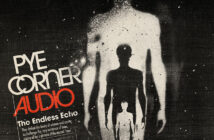
First impressions of ‘Lamne Gastama’: heavier than a white dwarf, harder than a diamond, more repetitive than The Simpsons, slower than a sloth, weirder than Jodorowsky, thicker than a soup of oil and blood and molasses; no drums, no drums, no drums; claustrophobic and cramped, there’s no air, there’s no room to breath, there’s no way to escape; guttural, bleak, unsettling and uncomfortable; fidgety and niggly with strange sounds twitching away at the edge of audibility; droning and grinding and murmuring and rumbling, building and building and building in intensity.
‘Lamne Gastama’ is the antithesis of easy listening. Effortlessly blending ‘real live instruments with their self-described “custom made instruments and software”, Mohammad’s ‘Lamne Gastama’ is more than just a blend of “low frequencies, inter-modulations, dark textures and distant folk nuances”. And it is more than just another left-of centre doom record or another example of experimental metal. While all of these traits are an undeniable part of ‘Lamne Gastama,’ the sounds conjured by Mohammad and the ‘songs’ that they create are more than just noise for noise sake or an exploration of density and texture. ‘Lamne Gastama’ is arguably intended more as a spiritual, contemplative and meditative springboard, as a series of soundscapes that strive to uncouple the rational and analytic side of our ‘listening’ brain, as a form of subtle hypnosis that lets us drift through the music in an almost trance-like way, thanks to its heavy use of repetition and drone.
‘Adar Toli’ builds a slow and repetitive guitar and cello-like drone-riff into a monolithic slab of weirdly spacey texture; each repetition adds another layer of treated sound to the original drone-riff, while artificial and synthetic noises fidget away in the gaps between instrument strikes – eventually, it becomes almost impossible to tell which is the sound of the original instruments and which is an artificial or synthetic noise, the whole lot teetering on the edge of collapse. ‘Hapsia’ begins more subtly, with a long half-whispered half-spoken vocal introduction that suddenly car-crashes into a rehash of the drone-riff from ‘Adar Toli’; this time, however, the sounds slowly degrade, their very essence fragmented and corrupted, only to rear up again – this process of domination and collapse repeats itself, each repetition weirder and more startling than the last.
‘Pichak’ is stranger still: centred on the buzz-burr of a bowed string instrument that might be a double bass or a cello or some fantastical combination of the two, the rest of the space is filled with frenetic guitar noodlings and sheets of feedback and glitches and hums and squawks and squeals that act as an increasingly chaotic counterpoint to the slow and steady and increasingly heavy buzz-burr of the bowed instrument. ‘Tik Tromakton’ is vastly different from its predecessors, and may be as subtle as Mohammad get: rather than simply opening with a sense of fury and intensity, it introduces a vast mix of drones and fidgety noises and treated instruments and unsettling textures piece-by-piece, over the course of 17 minutes. It is akin to the sound of a hundred different infernal machines slowly warming up and coming to life; by the end, they are all blaring and whirring and whining together, sometimes meshing and sometimes clashing.
Words don’t do ‘Lamne Gastama’ justice. It is an album to be experienced, an album to be felt, an album that should be played loud, an album that will carry you away.



